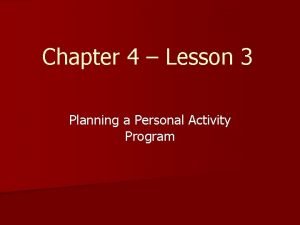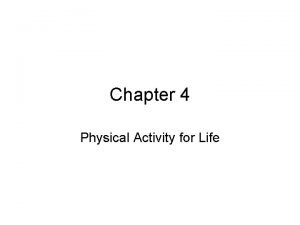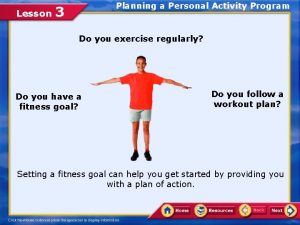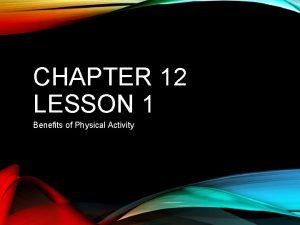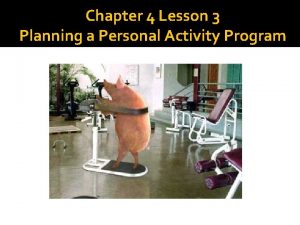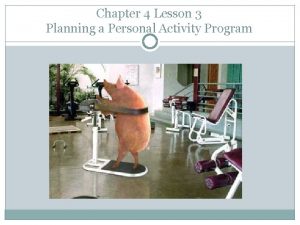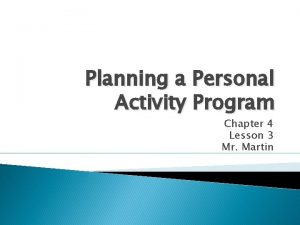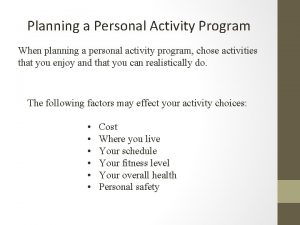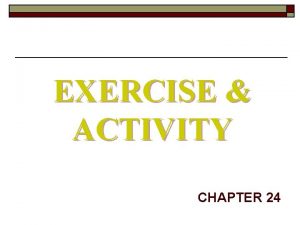Chapter 4 Lesson 3 Planning a Personal Activity














- Slides: 14

Chapter 4 – Lesson 3 Planning a Personal Activity Program

Setting Physical Activity Goals n Be realistic n Follow n Vary governmental recommendations your choices

Physical Activity Pyramid n Moderate Intensity – 30 min/day…walking, gardening, climbing stairs n Aerobic Activities – 2/3 days per week (all major muscle groups)…bicep curls, triceps extensions, abdominal curl, calf raise, etc n Flexibility – 2+ days/week (all major joints)…lunges, yoga, calf stretch, etc

n Anerobic – 3 -5 days/ week… 20 -60 min. …. Brisk walking, running, cycling, cross country skiing n Sedentary – top of pyramid!. . . infrequent…TV, computer games, internet, etc.

Choosing Activities n Things to consider – Cost (equipment, classes, trainers) – Convenience (location to home/work) – Your level of health (previous conditions, asthma) – Time/place (morning, evening, climate, travel time) – Safety (unsafe areas, after dark) – Comprehensive program (select activities that address all 5 fitness areas)

Cross Training n. A variety of activities to strengthen all muscle groups n Jump rope, swimming, jogging, cycling

Basic of a Physical Activity Program n Overload normal – working the body harder than n Progression – the gradual increase in overload necessary to achieve higher levels of fitness n Specificity – particular exercises and activities improve particular areas of health related fitness

The Stages of The Workout n Warm Up – an activity that prepares the muscles for work n Also gives time for the heart rate to increase gradually

The Workout n Part of an exercise program when the activity is performed at its highest peak n FITT Principle – follow this to be effective n Frequency – 3 -4 x’s / week…this depends on your fitness goals

Intensity n Working your muscles and cardiorespiratory system at an intensity that allows you to reach overload will help improve your fitness n It may take about 6 months before you can workout for 20 -30 minutes your target HR

Time/Duration n Slowly build up the amount of time you spend doing aerobic exercises n The goal is to work within your target HR for 20 -30 minutes n Weight training – do the exercises slowly, take rest in between sets n Target muscle groups and use a full ROM

Type n Max benefits 75 -80% of workout should be aerobic n 20 -25% should be anaerobic n The Cool Down n It is an activity that prepares the muscles to return to a resting state

Monitoring Your Progress n Keep a journal n Write down goals, FITT principles/week n Compare, or so evaluate, modify every 6 weeks

Resting Heart Rate n The number of times your heart beats in one minute (bpm) when you are not active n Best time of day…a. m. before you ‘get up’ n It can be used to evaluate your progress n Average fitness levels bpm of 72 -84 n A bpm of less than 72 indicates a good fitness level
 Chapter 12 lesson 3 planning a personal activity program
Chapter 12 lesson 3 planning a personal activity program Planning a personal activity program
Planning a personal activity program Chapter 12 lesson 3 planning a personal activity program
Chapter 12 lesson 3 planning a personal activity program The final step in planning a personal activity program is
The final step in planning a personal activity program is Chapter 2 personal financial planning answers
Chapter 2 personal financial planning answers Fitness chapter 12
Fitness chapter 12 Chapter 12 lesson 1 answer key
Chapter 12 lesson 1 answer key Chapter 5 lesson 3 a call to arms answers
Chapter 5 lesson 3 a call to arms answers Chapter 1 lesson 1 your total health
Chapter 1 lesson 1 your total health Reactants products and leftovers
Reactants products and leftovers Activity corrections
Activity corrections Aon and aoa network diagram examples
Aon and aoa network diagram examples Form content and use
Form content and use Activity 2 finding the sequence
Activity 2 finding the sequence Activity 1 2 3
Activity 1 2 3

